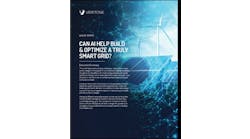Charlotte Mitchell, chairman of the North Carolina Utilities Commission, expressed relief when — at last — folks started to trickle into a talk on interconnection that she moderated yesterday at a national gathering of utility regulators in Washington, DC.
Mitchell’s worry — that the audience would be sparse — was understandable.
The “I” word — the interconnection of energy projects to the utility grid — is one of the biggest frustrations for microgrid developers — or pretty much anyone building grid-connected distributed energy resources (DERs).
Yet try to get energy insiders to work on interconnection issues and watch them head for the exit. It’s dry. It’s technical. But it’s also strangling DER growth in some parts of the US, as projects line up for interconnection approval, only to wait, wait, wait.
“Interconnection is maybe the bane of our existence. That’s being really dramatic, but interconnection is a very challenging issue that our jurisdiction has had to deal with over the past — it feels like forever — but the recent past, as the number of DERs, particularly, solar PV has increased,” said Mitchell, as she kicked off the interconnection panel discussion at the winter policy summit of the National Association of Regulatory Utility Commissioners, a five-day event which drew about 1,400 registrants.
Sometimes project developers just give up and quit the line.
What Colorado uncovered
Consider what happened in Colorado. A study by the staff at the state’s public utility commission found that 41% of community solar garden applicants withdrew from the interconnection queue, according to Megan Gilman, a commissioner at the Colorado Public Utilities Commission, who spoke on the panel, along with Carrie Zalewski, chairman of the Illinois Commerce Commission.
Colorado is not a place one would expect solar garden development to stall. The state is often credited with being home to the first solar garden in the US, and state lawmakers have worked to cultivate more.
“We really need to look at specific ideas to improve that success rate among community solar gardens,” Gilman said.
To collect the data for its study, the commission staff required information from the state’s two investor-owned utilities and asked its 22 electric cooperatives for voluntary reports. The investigators also sought anonymous input from energy developers, installers and owners through a survey.
“We wanted to be sure that everyone felt free to respond with the most honest responses they could, without any fear of anyone knowing who they were. They have to work with the utilities. And so sometimes people are sensitive to provide that sort of candid feedback,” Gilman said.
Despite the anonymity, the response rate was low, she said.
Still, from what commission staff could glean, the state suffers from inconsistent interconnection fees, lack of utility employees to work on interconnection applications, a solar interconnection application process that should be streamlined, and a lack of utility transparency about the process — although solar gardens that utilities developed themselves seemed to move slowly, too. Some utility projects took more than 18 months to complete.
Interconnection woes vary from state to state, and they are not confined to microgrids and small DERs. A new report by the Advanced Energy Economy (AEE) found more than 2,000 utility-scale clean energy projects have been delayed within the 13 states in PJM’s territory, some for years. The backlog caused the grid operator to recently announce a two-year moratorium on new applications.
The stalled projects represent 300,000 MW of solar, wind, hybrid and storage — enough to power 68 million homes and support more than 1.7 million direct and indirect jobs, according to AEE.
What developers think
AEE pointed to a LevelTen Energy survey where nine in 10 developers said interconnection delays and costs are the biggest barriers to the Department of Energy’s goal of 40% solar by 2035.
The good news? Before the interconnection panel came to a close, the room was half full with a couple of hundred people — or probably half empty to those who think interconnection needs to get a lot more attention.
Track news about DERs and interconnection. Subscribe to the free Microgrid Knowledge Newsletter.







